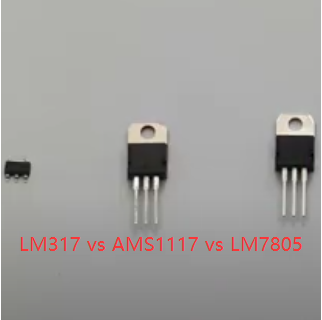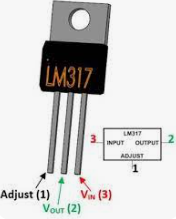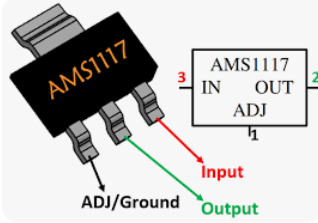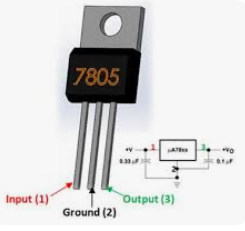
LM317 vs AMS1117 vs LM7805 Voltage Regulators Comparison
yunying Release time:2023-09-28 Page View:1845

- Introduction
- What is a voltage regulator?
- Overview of LM317
- Overview of AMS1117
- Overview of LM7805
- LM317 vs AMS1117 vs LM7805 Pinout
- LM317 vs AMS1117 vs LM7805: Difference in Applications
- LM317 vs AMS1117 vs LM7805: Difference in Features
- LM317 vs AMS1117 vs LM7805: Difference in Diagram
- LM317 vs AMS1117 vs LM7805: Datasheet
- Conclusion
- Product comparison
Introduction
Voltage regulators are crucial components in electronic circuits that ensure a stable and regulated output voltage regardless of input voltage fluctuations. They are commonly used to power various electronic devices, ranging from small integrated circuits to complex systems. This article aims to provide a comprehensive comparison of three popular voltage regulators: LM317, AMS1117, and LM7805. We will explore their features, pinouts, applications, and diagrams to help you understand their differences and choose the most suitable option for your project.
What is a voltage regulator?
A voltage regulator is an electronic component that maintains a constant output voltage regardless of changes in the input voltage or load conditions. It provides a stable power supply, protecting sensitive components from voltage fluctuations and ensuring reliable operation.
Overview of LM317
The LM317 is a versatile adjustable voltage regulator capable of providing a regulated output voltage between 1.2V and 37V. It features a three-terminal design, with an adjustable output pin, an input pin, and a ground pin. The LM317 is known for its high accuracy, low dropout voltage, and current limiting capabilities, making it suitable for a wide range of applications, including power supplies, battery chargers, and audio amplifiers.
Overview of AMS1117
The AMS1117 is a fixed voltage regulator that provides a constant output voltage without the need for external components. It is available in various fixed output voltages, such as 3.3V and 5V. The AMS1117 is a low dropout regulator with a three-terminal design similar to the LM317. It is commonly used in applications where a fixed voltage is required, such as microcontrollers, sensors, and digital circuits.
Overview of LM7805
The LM7805 is a popular fixed voltage regulator that provides a regulated 5V output. It is widely used in electronic circuits requiring a stable 5V power supply, such as microcontrollers, logic circuits, and sensors. The LM7805 features a three-terminal design and offers excellent load and line regulation, making it a reliable choice for many applications.
LM317 vs AMS1117 vs LM7805 Pinout
While all three voltage regulators have a three-terminal design, their pinouts differ. The LM317 and AMS1117 have adjustable and fixed output versions, respectively, while the LM7805 is fixed at 5V. It is important to consult the datasheets or pinout diagrams of each regulator to ensure proper connection in your circuit.
LM317

LM317 Pinout
AMS1117

AMS1117 Pinout
LM7805

LM7805 Pinout
LM317 vs AMS1117 vs LM7805: Difference in Applications
LM317: The adjustable output voltage range of the LM317 makes it suitable for applications requiring a wide range of voltages, such as bench power supplies, battery chargers, and audio amplifiers.
AMS1117: The fixed output voltage of the AMS1117 makes it ideal for applications that require a specific voltage level, such as microcontrollers, digital circuits, and sensors.
LM7805: The fixed 5V output of the LM7805 makes it a popular choice for powering microcontrollers, logic circuits, sensors, and other components that require a stable 5V supply.
LM317 vs AMS1117 vs LM7805: Difference in Features
LM317: The LM317 offers adjustable output voltage, high accuracy, and current limiting capabilities. It also has a built-in thermal overload protection feature.
AMS1117: The AMS1117 provides fixed output voltage options, low dropout voltage, and thermal overload protection. It is generally more cost-effective compared to the LM317.
LM7805: The LM7805 is a fixed 5V regulator with excellent load and line regulation, thermal overload protection, and short circuit protection.
LM317 vs AMS1117 vs LM7805: Difference in Diagram
The internal circuitry and block diagrams of these voltage regulators differ. It is recommended to refer to the datasheets or application notes provided by the manufacturers for a detailed understanding of their internal workings.
LM317 vs AMS1117 vs LM7805: Datasheet
Swipe to the end of the article to get LM317 Datasheet PDF, AMS1117 Datasheet PDF, LM7805 Datasheet PDF
Conclusion
Choosing the right voltage regulator depends on your specific application requirements. The LM317, AMS1117, and LM7805 are all reliable options with their own unique features and advantages. Consider factors such as adjustable vs fixed output voltage, cost, accuracy, current requirements, and thermal protection when selecting the appropriate voltage regulator for your project. Consulting datasheets, application notes, and seeking expert advice will help ensure a stable and efficient power supply for your electronic circuits.
Product comparison
-
ImagePart NumberManufacturerToleranceVoltage - RatedProduct StatusPackage / CaseProduct CategoryView Compare
-
-
-
-
TO-220-3
Voltage Regulators - Linear
-
-
-
-
TO-220-3
Voltage Regulators - Linear
-
2%
-
-
TO-261-4, TO-261AA
Voltage Regulators - Linear
-
-
-
-
-
-

Frequently Asked Questions
-
1,000+Daily Order Quantity
-
2,500,000+Alternative Parts
-
2,200+Worldwide Manufacturers
-
10,000 ㎡In-stock Warehouse





























